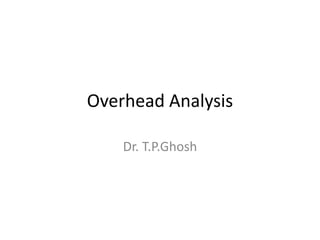
Overhead
- 1. Overhead Analysis Dr. T.P.Ghosh
- 2. Direct and Indirect Costs Costs incurred by cost centers are classified into two types a) Direct Costsb) Indirect Costs Costs which can be traced to the finished products manufactured are called ‘direct costs’. In other words a relationship between costs and finished products manufactured can be established. Costs which cannot be traced to the finished products manufactured are called ‘indirect costs’. They are also known as ‘Overheads’. This implies overheads can only be apportioned to the finished products.
- 3. Example of Direct & Indirect Costs A unit manufactures two products – Leather shoes & Leather walletsMaterial (Leather) used for both the products is traceable to them individually. However, expenditure of a common machine used in making both the products cannot be traceable to them. Therefore in the above case ‘Material’ would be a direct cost and ‘Machine expenses’ would be indirect cost.
- 4. Importance of Overhead allocation Total cost of product constitutes Direct Material, Direct Labor & Overheads. Direct Material and Direct Labor are directly traceable to the products manufactured. Accuracy of product cost computation depends on accurate distribution of overheads to products. Inaccuracies would lead to incorrect decisions – especially the pricing decisions. However, the method of overhead distribution should be chosen by considering time and cost factors in addition to accuracy.
- 5. How is overhead allocated ? Traditionally overhead apportionment to products was made in the following three step approach I) Primary Distribution (Allocation & Apportionment)II) Secondary Distribution (Re-apportionment)III) Absorption
- 7. Primary distribution Primary distribution of overheads which is also called as ‘Departmentalization’ of overheads involves allocation & apportionment. Allocation of overheads is made when they are traceable to cost centers. Overheads are apportioned when they are not traceable to cost centers. Apportionment is made using the most suitable bases.
- 8. Re-apportionment (Secondary Distribution) Cost centers are two types: a) Production Cost Centers: They are cost centers where finished products are manufactured b) Service Cost Centers: They are cost centers that support the production cost centers in manufacture of a productEx: Stores, Engineering, Purchase etc. Re-apportionment is a process where service centers costs are transferred to production centers.
- 10. Absorption The process of recovering overheads to cost of products is called ‘absorption’. In other words all the overheads allocated & apportioned to a department are finally absorbed by the units produced. Absorption of overheads can be made based on some suitable basis. The following are some of widely used methods of absorption: a) On the basis of ‘Production units’b) As a % of ‘Direct Labour Cost’c) As a % of ‘Direct Material Cost’d) As a % of ‘Prime Cost’e) On the basis of ‘Direct Labour Hours’ i.e. Labour Hour Ratef) On the basis of ‘Machine Hours’ i.e. Machine Hour Rate
- 11. Absorption….. Overhead absorption rates are determined based on any one of the methods stated in the previous slide. This rate is applied to individual cost units (products, services etc) to derive the total overhead absorbed. When actual overhead rate is applied on actual cost units, the actual and absorbed overheads would be equal. However if a pre-determined rate is applied on the actual base, it would result in a difference between actual and absorbed overheads. This would happen either because the actual base deviated from the budgeted base or the actual expenses deviated from the budget. If the absorbed overhead is more than the actual, it is called ‘over absorption’. On the other hand if the actual overhead is more than the absorbed overhead then it is called ‘under absorption’.
- 12. Activity Based Costing Traditionally cost accountants had arbitrarily added a percentage of expenses into the direct costs to include overheads. This method is quite satisfactory when the overhead costs are a small percentage compared to direct labor component in actual making of products. However as the percentages of overhead costs had risen, this technique became increasingly inaccurate because the indirect costs were not caused equally by all the products.
- 13. Problems of traditional method of overhead allocation It would lead to distortion of costs resulting in the following problems: a) Fixation of wrong selling prices (By pricing low profitable opportunities may be missed or by pricing high customers may be lost)b) Taking wrong decisions (product sales mix decisions etc) Instead of using broad arbitrary percentages to allocate costs, ABC seeks to identify cause and effect relationships to objectively assign costs. Once costs of the activities have been identified, the cost of each activity is attributed to each product to the extent that the product uses the activity.
- 14. How ABC works Instead of using broad arbitrary percentages to allocate costs, ABC seeks to identify cause and effect relationships to objectively assign costs. Once costs of the activities have been identified, the cost of each activity is attributed to each product to the extent that the product uses the activity. Cost drivers are used to measure the use of activities by different products / services.For example the cost of the activity ‘purchasing’ is measured by the number of purchase orders placed.
- 17. Four Steps of ABC System
- 18. A Simple Example of Overhead Allocation
- 24. Reciprocal method P= 67065 F =129194